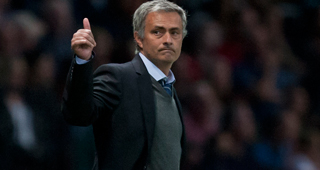José Mourinho downplayed expectations for his Chelsea side after returning last season from six years in Serie A and La Liga, calling his side a little horse that needed milk. The assessment was Mourinho’s logic at its best - although Chelsea competed for the league title last season, it wasn’t his team. And Mourinho sides accomplish the most in his second season anyway. Porto and Inter won the Champions League, and Real Madrid won La Liga, each in Mourinho’s second season. One of his many gifts as a manager is to distract our attention through press conferences and coaching mind games while he quietly builds, improves, weeds out, and strengthens a side into a thoroughbred ready to challenge in all competitions.
That methodical improvement seems at odds with the aura surrounding Mourinho. Wherever he goes, his legend tells us, he wins. Some managers play down expectations. “The Special One” hit the ground running with his first press conference as Chelsea manager in 2004. It was love at first quote, and full throttle from there. Chelsea won the league for the first time in 50 years by 12 points, setting records for fewest goals allowed, most clean sheets, most wins, and most points in a season. His Chelsea side repeated as champions his second season, then came in second in his third season.
And two months into his fourth season at Chelsea, he was gone.
The Schemes
From the armchair perspective, Mourinho had it easy his first time around at Chelsea. We live in a present day world of false 9’s, inverted wingers, inverted fullbacks, 3-5-2’s, Opta’s, and deep lying playmakers. Sure, Chelsea had world class players starting with Didier Drogba at front, but they out-schemed opponents with the numeric advantage of three versus two center midfielders. This tweak modernized the Premier League. Even Arsenal’s unbeaten side was described as a 4-4-2.
Claude Makelele controlled matches as the extra man in midfield while inventing his own position at the same time. His importance not only symbolized Mourinho’s effective pragmatism, but perhaps influenced tactics more than any player of his era. Yet today, most every English side plays a variant of three midfielders, backed with science, analytics, and spreadsheets. So what inefficiencies are left for Mourinho to exploit? Or are we missing the point?
To misquote Anna Karenina, successful managers are alike, combining some level of tactical nous, respect from players, charisma, sense of timing, arrogance and luck to win trophies. Deco credits Mourinho for saving his career during their time at Porto. Under Mourinho, center back Roberto Carvalho says, you “learn everyday”. Overlooked by tactics and analytics, there is still room for good, old fashioned coaching as exemplified by players improving from the previous year. And it’s telling that the theory behind Mourinho’s second season began with his players.
The Difference of a Decade
The marks we saw from Mourinho’s first time around are here today. There’s Nemanja Matic, described as the best holding midfielder in the league, in the Makelele role. Branislav Ivanovic and Cesar Azpilicueta are Paulo Ferreira and Wayne Bridge, two fullbacks expected to attack and defend. There’s the pragmatic, speedy width specializing in counters with Ramires, Andre Schurrle and Eden Hazard. Cesc Fabregas and Oscar will make Lampard-esque late runs from midfield. Finally, Diego Costa as Drogba, an impossible combination of skill, physicality, eye for goal, masterfully occupying two central defenders.
And there’s still his overarching focus on transitions, both from defense to attack and vice versa. With young managers making a name on exciting counter attacks, transitions are the soccer buzzword of the moment. Jonathan Wilson writes that Manchester City’s inability to counter counter-attacks may be their fatal flaw in both Europe and in the league. Chelsea are drilled to acknowledge the importance of both sides.
This present day Chelsea side have added another wrinkle of averaging three goals a match. Led by Costa’s movement and Cesc’s through passes, it’s safe to say the attack is much more dynamic and unpredictable than a decade ago. That side was lead by Lampard, Drogba, and Makelele - functional, disciplined and appropriate.
What position most defines a Mourinho side? The holding midfielder would be a good response. The position uses discipline, efficiency, and control expected of his, and really, any of the world’s best teams. Maradona said his Argentina side was “Mascherano and 10 others”. If Spain manager Vicente del Bosque were a player, he’d be Busquets. Matic “humbles” oppositions. But with Mourinho's treatment of Juan Mata and desire to sign Fabregas signals a subtle shift. In the contemporary era where every player is expected to defend, and all teams field a holding midfielder, Mourinho’s success may be counterintuitively defined by his most creative player.
Mourinho stated his desire to stay at Chelsea for another 12 years, then manage Portugal or England’s national side. Pep Guardiola posited that managers were only effective for three seasons before burning out, and Mourinho himself has stayed no longer than four seasons at Porto, Chelsea, Inter Milan and Real Madrid. He does appear more realistic this time, though spats with Arsene Wenger continue to carry over, and he found a new sparring partner in Manuel Pellegrini. But that’s part of the carefully crafted bigger picture. The art of Mourinho is in the diversion.



